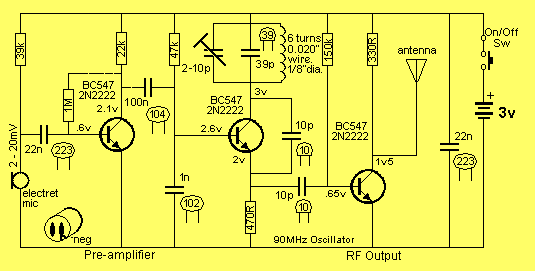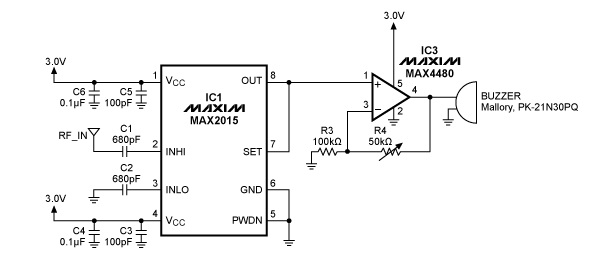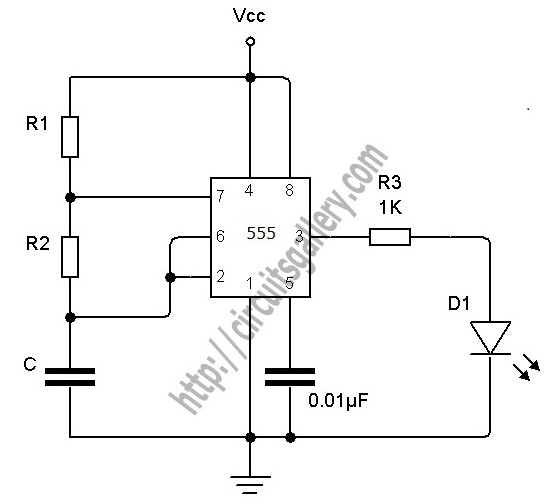
very stable BUG

Is a 100 to 200 metre (100 to 200yds) device having a very stable performance. It can be used as a hand held microphone or left on a shelf to pick up the sounds in a room. It has many interesting features. These will be fully described in the article. One of the most important features of this project is the use of standard components. This gives it universal appeal as the parts can be obtained from almost any electronics store. It has been designed, not only for Australia, but for all other countries, as the web covers the world and nearly every locality has an FM allocation in the 88-108 band. More: Since restrictions apply to FM transmitters in some countries, you will have to find out the laws in your locality before commencing construction. Some countries require a licence, some do not allow transmission at all, while others have set aside FM bands for specific uses.
This device operates within the FM frequency range of 88 to 108 MHz, making it suitable for various applications including personal broadcasting and ambient sound capture. The circuit design typically involves a microphone, an FM modulator, and an antenna. The microphone converts sound waves into electrical signals, which are then modulated onto an FM carrier wave by the modulator circuit.
The use of standard components such as operational amplifiers, resistors, capacitors, and transistors ensures that the circuit can be easily assembled and repaired, promoting accessibility for hobbyists and professionals alike. The choice of components also allows for flexibility in design, enabling modifications to enhance performance or adapt to specific requirements.
The FM modulator can be implemented using a simple transistor-based design, where the audio signal from the microphone is fed into the base of a transistor. The transistor acts as a switch, modulating the carrier frequency based on the input audio signal. This modulated signal is then transmitted via an antenna, which can be a simple wire or a more complex design depending on the desired range and quality of transmission.
It is essential to consider local regulations regarding FM transmission, as legal limits on transmission power and frequency allocation vary by region. Proper licensing may be required in certain areas, and compliance with these regulations ensures the device can be used without legal repercussions.
In summary, this handheld microphone and ambient sound capturing device is designed for ease of use and accessibility, making it a versatile tool for various audio applications while adhering to local broadcasting laws.Is a 100 to 200 metre (100 to 200yds) device having a very stable performance. It can be used as a hand held microphone or left on a shelf to pick up the sounds in a room. It has many interesting features. These will be fully described in the article. One of the most important features of this project is the use of standard components. This gives it universal appeal as the parts can be obtained from almost any electronics store. It has been designed, not only for Australia, but for all other countries, as the web covers the world and nearly every locality has an FM allocation in the 88-108 band. Since restrictions apply to FM transmitters in some countries, you will have to find out the laws in your locality before commencing construction. Some countries require a licence, some do not allow transmission at all, while others have set aside FM ba
🔗 External reference
This device operates within the FM frequency range of 88 to 108 MHz, making it suitable for various applications including personal broadcasting and ambient sound capture. The circuit design typically involves a microphone, an FM modulator, and an antenna. The microphone converts sound waves into electrical signals, which are then modulated onto an FM carrier wave by the modulator circuit.
The use of standard components such as operational amplifiers, resistors, capacitors, and transistors ensures that the circuit can be easily assembled and repaired, promoting accessibility for hobbyists and professionals alike. The choice of components also allows for flexibility in design, enabling modifications to enhance performance or adapt to specific requirements.
The FM modulator can be implemented using a simple transistor-based design, where the audio signal from the microphone is fed into the base of a transistor. The transistor acts as a switch, modulating the carrier frequency based on the input audio signal. This modulated signal is then transmitted via an antenna, which can be a simple wire or a more complex design depending on the desired range and quality of transmission.
It is essential to consider local regulations regarding FM transmission, as legal limits on transmission power and frequency allocation vary by region. Proper licensing may be required in certain areas, and compliance with these regulations ensures the device can be used without legal repercussions.
In summary, this handheld microphone and ambient sound capturing device is designed for ease of use and accessibility, making it a versatile tool for various audio applications while adhering to local broadcasting laws.Is a 100 to 200 metre (100 to 200yds) device having a very stable performance. It can be used as a hand held microphone or left on a shelf to pick up the sounds in a room. It has many interesting features. These will be fully described in the article. One of the most important features of this project is the use of standard components. This gives it universal appeal as the parts can be obtained from almost any electronics store. It has been designed, not only for Australia, but for all other countries, as the web covers the world and nearly every locality has an FM allocation in the 88-108 band. Since restrictions apply to FM transmitters in some countries, you will have to find out the laws in your locality before commencing construction. Some countries require a licence, some do not allow transmission at all, while others have set aside FM ba
🔗 External reference
Warning: include(partials/cookie-banner.php): Failed to open stream: Permission denied in /var/www/html/nextgr/view-circuit.php on line 713
Warning: include(): Failed opening 'partials/cookie-banner.php' for inclusion (include_path='.:/usr/share/php') in /var/www/html/nextgr/view-circuit.php on line 713





